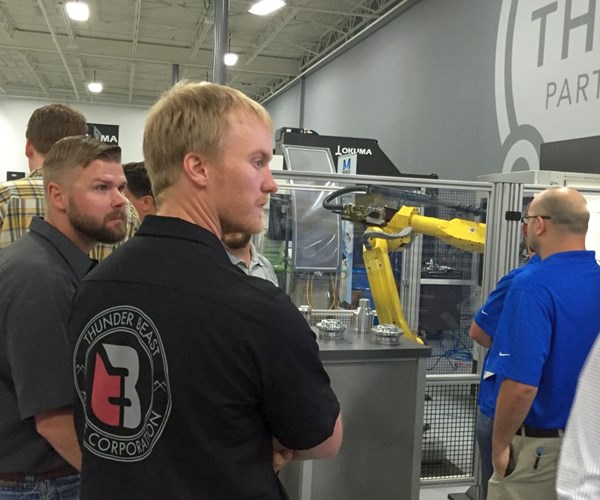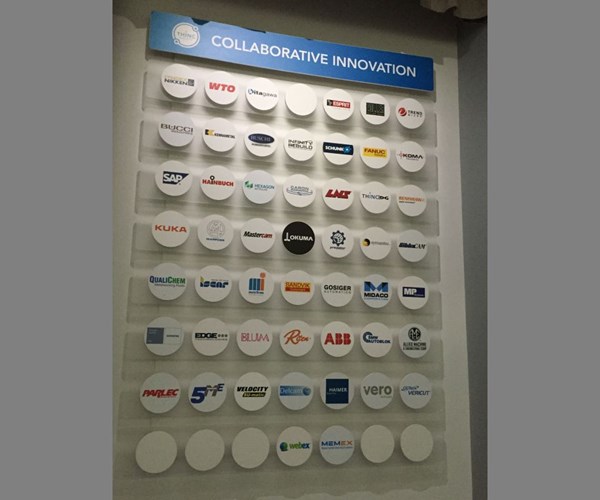Automation Evangelists Cast Wide Net
This recent event was hosted by a network of suppliers in a single location touting a single message: Automation isn’t necessarily time-consuming and expensive, even for smaller shops.
Share





Suppliers of workholding, robotics, machine tools and other key technologies demonstrated first-hand how manufacturers of all stripes stand to gain from implementing automation.
What comes to mind when you think about automation? For many, the answer is long lines of robot-fed, interconnected machinery, conveyor belts and more—the kind of thing you’d expect to see at a large, high-production operation with the resources to implement a factory that runs (and, increasingly, thinks) all on its own.
Although that’s certainly a valid answer, it’s also leaving a lot out. So says machine tool builder Okuma America Corp., which recently hosted an event with a specific focus on the notion that shops of all sizes stand to benefit from automation. What made this message so convincing, however, is that Okuma wasn’t the only one touting it. Hosted June 22 at the Partners in THINC facility down the street from the company’s headquarters in Charlotte, North Carolina, “Easy Shop Floor Automation” was the brainchild of not just Okuma, but also more than 15 members of its formal supplier partner network. Offering advice on maximizing the benefits of everything from bar feeders and parts catchers (yes, these are examples of automation) to robotics and flexible manufacturing systems, this diverse group of partners spoke with a single voice on how any size shop can benefit from technology that frees human beings from repetitive, time-consuming and low-value-added tasks.
Just in case that voice wasn’t loud or convincing enough, these suppliers were ready to prove the point on real-world equipment. Technology in action included:
- A Multus B300W mill-turn with Gosiger automation cell using FANUC robot and Kitagawa quick-change workholding
- Genos L250 with LNS bar feeder, Caron Engineering balancing and operational App
- Genos L300M with Gosiger Automation Cell using Kuka robot, Renishaw Equator, Caron Auto-Comp, infeed/outfeed conveyor
- ABB robotic drink-serving cell
- FANUC robot/Schunk Workholding changing cell
- Okuma 2SP-150H turning cell with integrated gantry system
Successful automation takes a village, and access to suppliers covering all key aspects of an integrated system makes relatively intimate, tightly focused events like this particularly valuable, says Jim Estes, director of Partners in THINC. “All in one building, attendees have access to metrology people, workholding people, people who can help improve tool life—all the knowledge and equipment that make automation effective,” he says. He adds that such events provide great opportunities to see how technology is evolving, citing work on technology that could provide fast, precise non-contact measurement as part of a seamless automated machining process. “This is coming, and it’s going to work in an environment with coolant and chips to complement the current touch-probe systems,” Mr. Estes says.

Partners in THINC is a network of more than 46 companies that collaborate to solve problems and explore the possibilities of manufacturing technology.
Related Content
-
Four-Axis Horizontal Machining Doubles Shop’s Productivity
Horizontal four-axis machining enabled McKenzie CNC to cut operations and cycle times for its high-mix, high-repeat work — more than doubling its throughput.
-
4 Steps to a Cobot Culture: How Thyssenkrupp Bilstein Has Answered Staffing Shortages With Economical Automation
Safe, economical automation using collaborative robots can transform a manufacturing facility and overcome staffing shortfalls, but it takes additional investment and a systemized approach to automation in order to realize this change.
-
Managing Coolant with Skimmers, Refractometers and More
Bacteria-infected coolant harms machines and sickens machinists. Coolant management technologies like skimmers and automated systems counter this tendency.






















